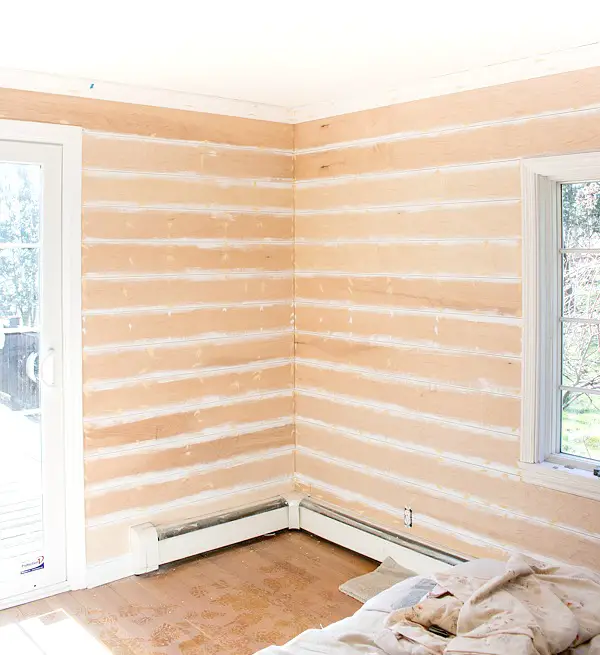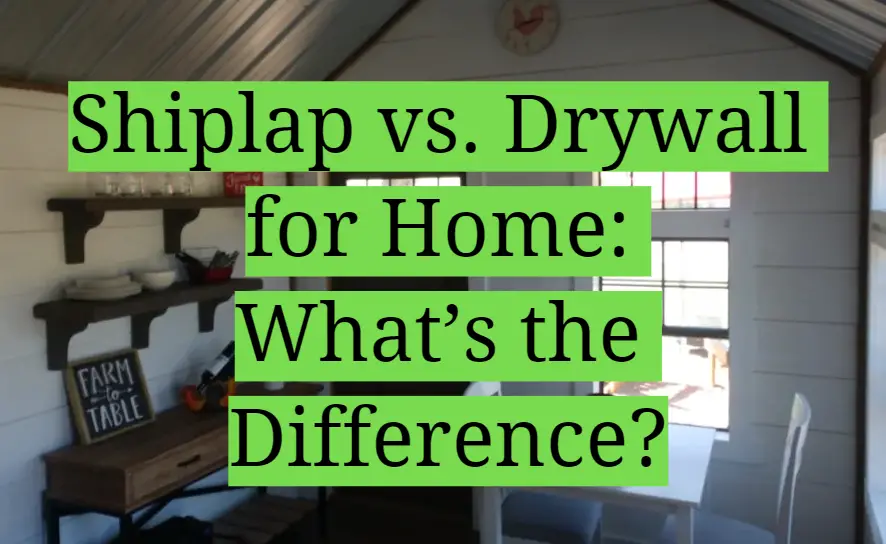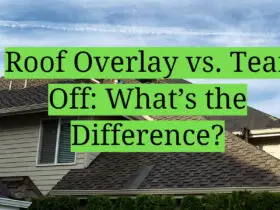If you’re looking to renovate or remodel your home, you may be wondering what material to use for the walls. Shiplap and drywall are two popular options, but which one is right for you? In this blog post, we will discuss the pros and cons of both materials and help you decide which is best for your home!
What Are Shiplap Walls?
Shiplap walls are a type of wall paneling that has been around for centuries. The name comes from the horizontal boards that are used to create the panels. Shiplap is usually made from wood, but it can also be made from other materials like aluminum or vinyl. [1]

What Is Drywall?
Drywall is the standard material for walls and ceilings in most homes. It’s made of panels of gypsum plaster sandwiched between two layers of heavy paper. The panels are then fastened to the framing members of the walls or ceiling with screws and nails. Drywall is relatively easy to install, and it’s a very forgiving material— meaning that it’s easy to make repairs if you need to.
Shiplap Vs Drywall
1. Appearance And Versatility
Shiplap has a more rustic appearance with its rough-hewn edges, while drywall has a smoother finish. Shiplap can be painted or stained to match your home’s aesthetic, while drywall is typically left white.
2. Durability
Shiplap is more durable than drywall and can withstand bumps and scratches. Drywall is more susceptible to damage and will show signs of wear over time.

3. Cost
The cost of shiplap vs. drywall is another important consideration for your home. Shiplap can be more expensive than drywall, but it also depends on the quality of the materials used.
4. Quick And Easy Installation
Drywall is a time-consuming process that requires careful measuring, cutting, and nailing. Shiplap, on the other hand, is a much quicker and easier installation process. If you’re looking for a project you can complete in a weekend, shiplap may be the way to go. [3]
5. Less Messy Installation
Drywall installation can be pretty messy. There’s all the dust that comes with cutting the drywall to size, and then you have to worry about mudding and taping. With shiplap, there’s no need for mud or tape since the boards fit snugly together.
6. Painting And Maintenance
Paint is one of the easiest ways to update a room, and it’s also one of the quickest and cheapest ways to give your shiplap walls a new look. You can paint shiplap any color you want, which gives you a lot of flexibility when it comes to design. As for maintenance, all you need to do is wipe down the boards with a damp cloth if they get dirty.

7. Ease Of Hanging Objects
If you want to hang anything on your walls, it’s a lot easier to do so with shiplap. You can simply nail or screw the boards into the wall, and then hang your pictures, mirrors, or shelves. With drywall, you have to find the studs in order to properly hang anything.
Benefits and Disadvantages of Shiplap
Shiplap has a number of benefits that make it a popular choice for homeowners. First, shiplap is very durable and will last for many years. Additionally, shiplap is easy to install and can be done by most people with basic carpentry skills. Finally, shiplap gives your home a rustic look that many people find appealing.
There are also some disadvantages to using shiplap in your home. One downside is that shiplap can be expensive, depending on the type of wood you use. Additionally, shiplap can be difficult to repair if it becomes damaged. Overall, though, the advantages of shiplap usually outweigh the disadvantages for most homeowners.
Benefits and Disadvantages of Drywall
Drywall is the most common type of wall material used in homes today. It is made of gypsum board that is covered with paper or fiberglass matting. Drywall is easy to install and finish, making it a popular choice for many homeowners.
However, there are some disadvantages to using drywall in your home. One disadvantage of drywall is that it is not as durable as other types of wall materials. Drywall can be easily damaged by water, fire, or insects. If you live in an area where these threats are common, you may want to consider another type of wall material for your home.
Another disadvantage of drywall is that it does not have the same insulation value as other materials. This means that your home will not be as energy-efficient as it could be if you used another type of wall material.
How to Install Shiplap?

Shiplap is a type of wooden board that is often used for walls and ceilings. It is easy to install and can give your home a rustic or farmhouse feel. If you are considering shiplap for your home, here are a few things to keep in mind:
- Shiplap can be more expensive than drywall.
- Shiplap should be installed by a professional if you want it to look its best.
- Shiplap can be painted or stained any color you like.
- Shiplap adds character and charm to any space.
If you’re looking to add some character and charm to your home, shiplap may be the way to go. This type of wooden board is easy to install and can be painted or stained any color you like. However, it’s important to keep in mind that shiplap can be more expensive than drywall and should be installed by a professional if you want it to look its best.
Installing shiplap is relatively simple. First, you’ll need to measure the area where you want to install the boards and cut them to size. Next, use a level to mark where you’ll place the first board on the wall. Once the first board is in place, continue measuring, cutting, and installing the rest of the boards until the area is complete. [4]
How to Install Drywall?
Drywall installation is a bit more involved than shiplap. You’ll need to use screws and nails to attach the drywall panels to the studs in your walls. Drywall compound is also used to fill in any gaps or seams between the panels. Once the drywall is up, you can then start painting or adding wallpaper. Shiplap, on the other hand, doesn’t require any additional finishing once it’s installed. [5]
How to Clean Shiplap?
To clean shiplap, you will need to use a mild cleaner and a soft cloth. You can also use a vacuum with a soft brush attachment to remove any dust or dirt from the surface. Once you have cleaned the shiplap, you will need to apply a sealer to protect the wood from moisture and other damage.
How to Clean Drywall?
Cleaning drywall is a simple process that can be done with a few household items. You will need a vacuum, bucket, soap, and water. First, use the vacuum to remove any dust or debris from the surface of the drywall. Next, mix a solution of soap and water in the bucket. Dip a sponge in the solution and scrub the surface of the drywall. Finally, rinse the area with clean water to remove any soap residue. [6]
Which Is Better?
There are a few key differences between shiplap and drywall that you should know before deciding which is best for your home. Shiplap is typically made of wood, while drywall is made of gypsum. This means that shiplap is more durable and will last longer than drywall. Additionally, shiplap has a tongue-and-groove design that allows it to fit together tightly, while drywall does not have this feature. This makes shiplap less likely to crack or crumble over time. Finally, shiplap is often used as an accent wall or in other areas where you want to add architectural interest, while drywall is more commonly used for ceilings and walls in general.
So, what’s the bottom line? If you’re looking for durability and a long-lasting material, shiplap is the way to go. If you want something that’s more budget-friendly and easy to install, drywall is your best bet. Whichever route you choose, make sure to consult with a professional before getting started. They can help you determine which option is best for your home and answer any questions you may have.
FAQ
Is shiplap better than drywall?
It really depends on what your goals are for your home. If you’re looking for a more rustic feel, shiplap is definitely the way to go. However, if you’re going for a more modern look, drywall is probably a better option.
What’s the difference between shiplap and drywall?
Shiplap is typically made of wood, while drywall is made of gypsum board. Shiplap has grooves that fit together tightly, while drywall does not. This gives shiplap a more rustic appearance. Drywall is smoother and more consistent in its appearance.
Is shiplap hard to install?
No, shiplap is not difficult to install. In fact, it can be installed in a similar way to drywall. However, because shiplap is made of wood, it may be more susceptible to damage from moisture and temperature changes.
Is drywall hard to install?
No, drywall is not difficult to install. It can be hung in a similar way to shiplap, but because it’s made of gypsum board, it’s much lighter and easier to work with. Drywall is also less likely to be damaged by moisture and temperature changes.
What are the benefits of shiplap?
Shiplap has a number of benefits, including its rustic appearance, durability, and easy installation. Shiplap is also relatively inexpensive, making it a great option for those on a budget.
What are the benefits of drywall?
Drywall has a number of benefits, including its smooth appearance, fire resistance, and soundproofing qualities. Drywall is also very versatile, as it can be painted or textured to match your home’s décor.
Can I use shiplap instead of drywall?
The short answer is yes, you can use shiplap instead of drywall in your home. Shiplap is a type of wooden board that is often used for siding on barns and other buildings. Drywall is a type of wallboard that is made from gypsum and paper.
Is interior shiplap expensive?
No, interior shiplap is not expensive. In fact, it is often less expensive than drywall. Shiplap is also easier to install than drywall and does not require specialized skills or tools.
What are the disadvantages of shiplap?
Shiplap can be more difficult to repair than drywall if it becomes damaged. Additionally, shiplap may not provide as good of a sound barrier as drywall. However, overall, shiplap provides a number of advantages over drywall for use in your home.
Is interior shiplap hard to maintain?
No, interior shiplap is not hard to maintain. In fact, it is often easier to clean than drywall. Shiplap is also resistant to mold and mildew, making it a good choice for damp or humid areas.
How to maintain drywall?
Drywall is easy to maintain. You can clean it with a damp cloth or a vacuum cleaner with a soft brush attachment. To remove tough stains, you can use a mild detergent and scrub the area with a sponge. Be sure to rinse the area well afterwards to remove any residue. You should also avoid using harsh chemicals or abrasives on drywall, as these can damage the surface.
How to care for shiplap?
Shiplap is a type of wooden board that is often used for walls and ceilings. The boards are placed horizontally on the wall, with each board overlapping the one below it. Shiplap can be left natural or painted. It’s important to note that shiplap should not be confused with tongue and groove, which is a similar type of wood paneling.
Do you put anything behind shiplap?
You don’t necessarily need to put anything behind shiplap, but you may want to if you’re using it in a high-traffic area or an area that is prone to moisture. Drywall is more durable than shiplap and can withstand more wear and tear. However, shiplap can add a rustic charm to your home that drywall cannot match. If you’re unsure which material is right for your home, consult with a professional contractor or interior designer. They will be able to help you decide which option is best suited for your needs.
Can shiplap get wet?
Shiplap can get wet, but it is not as durable as drywall and may start to warp or rot if it is constantly exposed to moisture. If you live in an area that is prone to flooding or hurricanes, you may want to consider using drywall instead of shiplap.
What is so special about shiplap?
Shiplap has a rustic charm that is unmatched by drywall. It can add character to your home and give it a unique look.
Useful Video: The Cost of Wood Walls vs Drywall
Conclusion
So, what’s the verdict? Shiplap or drywall?
The answer may depend on your specific needs and preferences. If you want a rustic look for your home, shiplap may be the way to go. On the other hand, if you prefer a more traditional look, drywall is probably your best bet.
Whichever route you choose, make sure you consult with a professional to get the best results for your home. Thanks for reading!
References
- https://www.thespruce.com/what-is-shiplap-5225719
- https://home.howstuffworks.com/home-improvement/home-diy/projects/drywall.htm
- https://oldworldgardenfarms.com/2017/11/12/shiplap-vs-drywall/
- https://www.hgtv.com/how-to/home-improvement/how-to-install-shiplap
- https://www.homedepot.com/c/ah/how-to-hang-drywall/9ba683603be9fa5395fab90cbb4826d
- https://www.homestratosphere.com/clean-drywall/














Leave a Reply